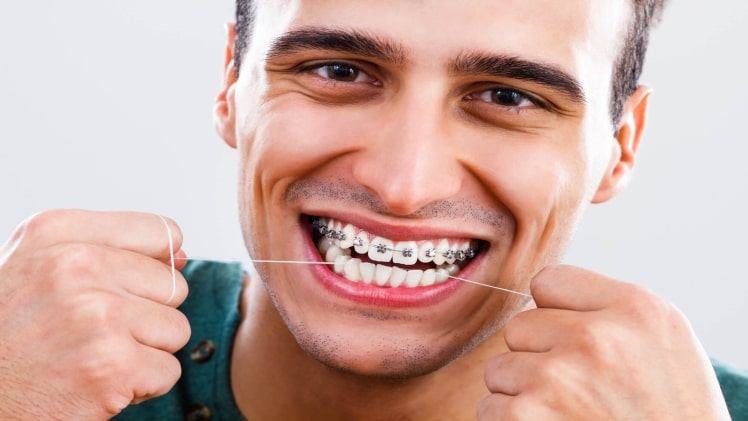For people who wear braces, it’s important to practise basic oral hygiene to avoid food debris and bacterial plaque from building on your braces and teeth. As wires and brackets of the braces are fragile, they can make brushing and flossing difficult. Additionally, damaged or loose brackets, as well as protruding wires, can injure the inside of your mouth.
Many things can damage your braces – for example, facial injuries, nail-biting or even by chewing hard substances. When your braces are damaged, loose brackets, as well as protruding wires, can cause injury inside your mouth. Thus, it’s important to keep your braces clean and in good condition.
1. Routine and Proper Brushing
Alongside brushing your teeth two times a every day, you will need a routine for brushing in order to keep your braces clean. The longer you keep bacteria in your braces and your teeth the higher the chance that you’ll experience issues such as dental decay, discolouration or gum inflammation. The best guideline is to wash your teeth following each meal, and then rinse the area with water to wash away food particles stuck within the braces and around them. Follow the steps below to wash your braces more thoroughly:
- Clean each tooth along an angle at the line of gum, both above and below the brackets using fluoridated toothpaste as well as soft-bristled brushes in the case of braces.
- To clean the brackets on the upper side to clean the brackets, put the brush head on top of them and then tilt it down.
- Then, by moving upwards, you can adjust your brush’s position towards the bottom of each bracket and scrub it clean.
- Rinse your mouth with antiseptic fluoride or mouthwash that is antibacterial.
If you’re not able to clean your teeth after eating, wash the mouth using water. Regularly brushing your teeth is vital, however over-brushing can cause gum recession and sensitive teeth So, make sure you utilize a soft-bristled tooth brush to prevent harming your gums and teeth in the future.
2. Follow with Floss
Floss at least every morning and before bedtime to eliminate any food debris to prevent plaque from forming. After each floss, remove the wires behind and in between brackets. When flossing with braces be sure to follow the correct method to avoid gum inflammation, and bad breath.
It is better to use floss that has been waxed (sometimes called “superfloss”) as it can easily glide through your mouth. Contrarily floss that’s not waxed is more likely to latch onto braces and break. If you have noticeable spaces between your teeth then an intradental toothbrush could be the best option and an oral irrigator is helpful in cleaning difficult-to-access areas.
Note that it can take three times longer to get braces. But don’t hurry it. The aim is to make sure that your braces are in good condition.
3. Professional Cleaning
If you wear braces regular flossing and brushing can aid in maintaining your teeth. However, braces, wires and bands may cause it to be impossible to get rid of tartar, plaque and discolouration from your teeth.
This is where professional cleanings can aid in preventing gingivitis as well as the demineralisation of the teeth around brackets where plaque is more likely to stay. To prevent dental problems make sure you schedule a dental consultation with your dentist each six-month period or in some cases 3 times a year depending on the state that your brackets are in.
4. Use Tooth Mousse
Tooth mousse is a calcium and phosphate-based supplement that aids in replenishing minerals in your teeth. Tooth mousse has been demonstrated to reduce spots of white or yellow spots around brackets due to uncleaning your teeth.
Clean the brackets thoroughly and apply a thin coating of tooth mousse on the brackets every day to stop the growth of lesions that look like white spots. Tooth mousse is available at your local drugstore or pharmacist.
5. Stick to Your Orthodontist Appointments
Orthodontic treatments are considered a close collaboration between you and your orthodontist/dentist. Thus, it’s best not to miss any dental appointments. For example, the results of an invisible teeth straightening procedure will be measured within a set timeframe. If any adjustments are required, they should not be delayed, or you will risk affecting the end results.
6. Say NO to Sugar
When wearing braces, avoid sugary drinks because they can harm both your braces and teeth. Sugary, acidic, and carbonated beverages might degrade the glue that holds your braces in place. They can also make it more likely for a bracket to pop out, allowing germs to fester below it and start forming cavities.
Carbonated drinks and fruit juices are generally heavy in sugar and are acidic, causing tooth enamel to deteriorate dramatically. So stick to water or unsweetened beverages. If you have removable Invisalign aligners, remember to remove them whenever you consume a sugary drink. It’s also a good idea to avoid sweet foods such as cakes and ice creams.
Touch here: ifsptv Visit here: smihun And Read more about: snapinsta Visit more here: igviewer
Getting braces can help you look your best and give you a perfect smile! However, you would also need to make an effort to take good care of them. If you or someone you know is thinking about getting braces, look for an experienced orthodontist or a dental clinic familiar with adult orthodontics procedures to guide you through the process.

